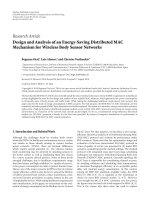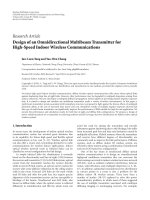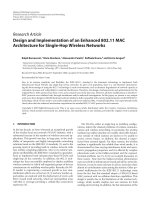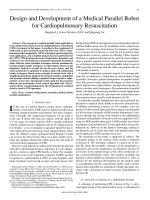DESIGN AND DEVELOPMENT OF AN OMNIDIRECTIONAL MOBILE BASE FOR a SOCIAL ROBOT
Bạn đang xem bản rút gọn của tài liệu. Xem và tải ngay bản đầy đủ của tài liệu tại đây (3.83 MB, 73 trang )
Design and Development of an Omnidirectional
Mobile Base for a Social Robot
LIM HE WEI
NATIONAL UNIVERSITY OF SINGAPORE
2011
Design and Development of an Omnidirectional
Mobile Base for a Social Robot
LIM HE WEI
(B.Eng.(Hons), NUS)
A THESIS SUBMITTED
FOR THE DEGREE OF MASTER OF ENGINEERING
DEPARTMENT OF MECHANICAL ENGINEERING
NATIONAL UNIVERSITY OF SINGAPORE
2011
Acknowledgement
I would like to express my warm and sincere thanks to Professor Marcelo Ang Jr from the
department of Mechanical engineering, National University of Singapore who introduced me to
the systematic and analytical approach to robotic systems. His support and trust as supervisor
and mentor has helped me in many aspects of my higher studies endeavor from engineering
know-how to psychological approach towards understanding “mind-numbing” mathematics
involved in robotics. Words cannot describe the “calmness” which I observed and learnt from
him.
Professor Sam Ge from Electrical Engineering and also director of Social Robotics Lab have also
helped and encouraged me in my partaking of this Masters of Engineering. His attitude towards
engineering and the business surrounding engineering is positively radical. Despite the gap
between our capabilities, he spent significant time and effort in educating and helping all whom
worked with him. I respect him for being an agent of change and sincerely thank him for his
mentorship which firmed up my decision to enter the industry early. The many members of the
Social Robotic Lab have also been pivotal in shaping my engineering pursue path.
I would like to extend my gratitude towards Dr, John-John Cabibihan whom provided
engineering advice and “listening ear”, laboratory mates Haibin and Tiffany, former FYP and
BTech students who worked on earlier powered castor robots and current social robots who have
helped in both engineering and team support. Lastly, I would like to thank my family members
and close friends who have been nothing but supportive in one way or another. Thank you very
much.
I
Abstract
In this thesis, we examine the design, development and implementation of a mobile base for our social
robot – Robotubby. Robotubby is a social robot envisioned to be a companion to children capable of
social interaction and participating in meaningful edutainment tasks. The development of Robotubby
involves other researchers investigating other areas of social robotics thus the mobile platform must be
compatible and easy to integrate together.
Physically, Tele-tubby is a wheel-based mobile humanoid with movable torso, two robot arms and an
expressive face in order to display gestures and facial expressions that potentially convey emotions and
better communication. As a child companion, the size of the robot plays a critical role both for safety and
approachability. Given the indoor environment of homes, the mobile platform requires good
maneuverability to traverse its environment.
One key feature of Robotubby is the ability to conduct tele-presence which refers to a set of technologies
allowing users to feel present or have an effect of presence at the particular event which are typically
physically distanced from the user. A consideration of network technologies is necessary for the
development of the mobile platform and the means of control for users.
A Powered-Castor wheel (PCW) design for the mobile platform is selected for the merits of Omnidirectional travel as indoor environments such as homes are typically space-constrained. Compared to
other solutions such as Omni-directional wheels, PCW maintains perpetual contact with the ground for
smooth floors, providing smoother motion and less operation noise. Controlling of a PCW platform based
on prior works provide the foundation for developing omni-directional control via a joystick with handle
twist either locally or over the network. In experimentation, the mobile platform was able to perform the
task of moving around on a level ground with relative ease except for some jitters due to the nature of the
motor controller feedback.
II
Table of Contents
CHAPTER 1
INTRODUCTION
1
CHAPTER 2
LITERATURE REVIEW
5
2.1
Robot Architecture
5
2.2
Review of mobile Robots
6
2.2.1
Holonomic actuation:
7
2.2.2
Differential drive system:
7
2.2.3
Holonomic wheels:
9
2.2.4
Powered Castor Wheel:
10
Review of kinematic Models
11
2.3
2.3.1
Robotics modelling and control:
11
2.3.2
Forward Kinematics of single castor wheel
12
2.3.3
Inverse Kinematics of single castor wheel
19
Kinematics of a multi-caster wheels system
20
2.4.1
Inverse kinematics of multi-caster wheels
20
2.4.2
Forward kinematics of multi-castor wheels
21
2.4
CHAPTER 3
DESIGN AND IMPLEMENTATIONS
23
3.1
Mechanical design
23
3.2
Software system:
27
3.2.1
Global Coordinate Frame
29
3.2.2
Velocity Input Mode
30
3.2.3
Trajectory Planner
30
3.2.4
Vehicle Velocity Control Module
32
3.2.5
PD Controller
33
3.2.6
PID Controller
34
3.2.7
PI Control Loop
35
3.2.8
Tuning
36
III
3.3
3.3.1
Network control and implementation
39
Integration with Robotubby
CHAPTER 4
40
REVIEW OF IMPLEMENTATIONS
41
4.1.1
Hardware design and development
41
4.1.2
Experimental data: Servo
42
4.1.3
Experimental data: robot
46
CHAPTER 5
5.1
CONCLUSIONS
51
Future works
51
BIBLIOGRAPHY
53
ANNEX A: DYNAMIXEL SERVO CONTROL
55
ANNEX B: ROBOT CONVENTION AND REFERENCE
63
ANNEX C: USING THE GRAPHICAL USER INTERFACE
64
IV
List of Figures:
Figure 1-1: Role of Social Robots in today’s society, as companion to elderly, children and assistant
people to overcome various handicap [2] ................................................................................................. 1
Figure 1-2: Various modes of locomation for social robots ...................................................................... 2
Figure 1-3: HRI in Social Robot Design, form and function [2]................................................................ 3
Figure 1-4: Examples of Tele-robotics, task in communication, education and assistance ......................... 3
Figure 2-1: Example of social robot architecture for execution and robot behavioral layer........................ 6
Figure 2-2: Differential Drive Modeling for Navigation ........................................................................... 8
Figure 2-3: coupling of orientation and Position....................................................................................... 8
Figure 2-4: Mecanum wheels in different forms and number of rollers ..................................................... 9
Figure 2-5: Caster Wheel and Operation Model ..................................................................................... 10
Figure 2-6: Joint Schematics showing relationship between various links............................................... 12
Figure 2-7: Modeling of the caster wheel as a 2 dimensional planar manipulator .................................... 13
Figure 2-8: Resultant velocities of different links ................................................................................... 13
Figure 2-9: Orientation of base frame, B ................................................................................................ 17
Figure 2-10: Position of base frame, B, with regards to end-effector frame............................................. 17
Figure 3-1: Caster Linkage Modeling .................................................................................................... 24
Figure 3-2: Skate Scooter Wheels with customised wheel hub ............................................................... 24
Figure 3-3: Robotis RX-28 servo and Standard Industrial castor wheel frame ........................................ 25
Figure 3-4: Wheel driving unit of Powered Castor Wheel ...................................................................... 25
Figure 3-5: Powered Castor Wheels for RoboTubby .............................................................................. 25
:
Figure 3-6 Multithreading in Winform ................................................................................................ 27
Figure 3-7: Current GUI for functional testing ....................................................................................... 27
Figure 3-8: flowchart of operation ......................................................................................................... 28
Figure 3-9: Relationship between Global Frame and Base Frame ........................................................... 29
Figure 3-10: PD control for servo system ............................................................................................... 33
Figure 3-11: PID control for servo system ............................................................................................. 34
Figure 3-12: Motor Control loop............................................................................................................ 38
Figure 3-13: Basic Understanding of Internet Operation ........................................................................ 39
Figure 3-14: Trial implementation of Networked control ....................................................................... 40
Figure 4-1: Sine wave setpoint for the motor to trace without delay ....................................................... 42
Figure 4-2: Sine wave setpoint for motor to trace with delay of 0.1ms.................................................... 43
V
Figure 4-3: RX28 servo response to maximum speed impulse ................................................................ 44
Figure 4-4: Rx 28 Servomotor Square wave input .................................................................................. 45
Figure 4-5: Zoomed in view of Square wave input ................................................................................. 45
Figure 4-6: Current design of PCW platform ......................................................................................... 46
Figure 4-7: Omni-directional drive translation motion............................................................................ 48
Figure 4-8: Omni-directional rotational and translational motion ........................................................... 49
Figure 0-1: Layout of base frame ........................................................................................................... 63
VI
List of Symbols
X&
=
Cartesian velocities
x&
=
Translation velocity in X direction
y&
=
Translation velocity in Y direction
θ&
=
Rotation velocity in Z direction
Q&
=
PCW joint velocities
ρ&
=
PCW drive velocity
φ&
=
PCW steering velocity
J
=
Jacobian matrix linking joint velocities to Cartesian velocities
Va
=
Applied armature voltage, V
ia
=
Armature current, A
Ra
=
Armature resistance, Ω
La
=
Armature inductance, H
Vb
=
Back EMF, V
T
=
Torque developed by the motor, Nm
J
=
Equivalent moment of inertia of the motor and the load referred to
the motor shaft, kgm2
b
=
Equivalent viscous-friction coefficient of the motor and load referred
to the motor shaft, Nmrad-1s-1
m
=
mass of load, kg
VII
Chapter 1
Introduction
Social robotics is increasingly relevant in today’s world as more societies are maturing faster, reaching
the graying population paradigm in a few short decades. Researches in the multi-disciplinary fields of
social robotics have developed significantly over the past few years [1] with one of the goals of
addressing the above real-world issues. In creating the “social” into more commonly known robots in
industrialized settings, many researchers have undertaken the task of understanding and creating effective
social interaction with robots also known as Human Robot Interaction (HRI). Examples of social robotic
task include personal assistant, companion robot and handicap aid as seen in Figure 1-1.
Figure 1-1: Role of Social Robots in today’s society, as companion to elderly, children and
assistant people to overcome various handicap [2]
To understand the phenomenon of Social Robots and the field of HRI, we can refer to mankind’s history for
artificial beings development, robots medieval by today’s standards but still capable of complex motion
by clockwork engines. In the famous play by Karel Capek, the term robots was first coined in the title
“Rossum’s Universal Robots” (R.U.R) depicting moving mechanical machines as slave workers. The
theme of robots continue to evolve with robots increasingly seem human despite not having human or
humanoid form.
Physically, the design of the mobile base focuses on form and function that would make Robotubby a
likable social robot with good usability. The environment Robotubby operates in is almost exclusively
1
indoors and has to traverse the dynamic grounds that filled with furniture, ornaments and even children’s
toys. The mobile platform thus has to be able to maneuver well around such environments in order to
perform task such as navigate around to locate the child at home. Examples of different locomotion in
robots are shown in Figure 1-2.
Locomotion allows social robots to navigate their surroundings and perform their assigned service to
people. In the design of locomotive mechanisms [3,4], wheeled systems are most robust can observed in
all modern land transports. Nevertheless, such designs on an indoor social robot must fulfill certain
criteria like getting out of tight spots easily and navigating uneven terrain such as children’s toys strew all
over the floor. This thesis presents a caster-wheel platform design for a social robot that can navigate a
home environment seamlessly and able to perform other task.
Figure 1-2: Various modes of locomation for social robots
Social-ness and sociability is a man-made concept we typically attribute to matter we come into contact
with. In this respect, social robots can be applied to machines we interact with like computers, printers
and even autonomous vacuum cleaners. Designing HRI into everyday machines we interact with can
improve the wellbeing of people using these machines. Many experiments have been conducted with how
humans react to robots or even machines and researchers test how to make the interaction experience
more pleasant.
Designing the sociability of the mobile platform with respect to physical is mostly on the appearance and
more importantly appeal such as the robots in Figure 1-3 with child-like features and smooth coverings.
This particular aspect will not be covered as external design will be covered as the whole robot.
Designing Robotubby’s sociability will be more of software with respect to motor control.
2
Figure 1-3: HRI in Social Robot Design, form and function [2]
Social robotics provide the integral bridge between the virtual information world and the physical world
we live in thus allowing the provision of practical help to people in-need. Figure 1-4 shows examples of
social robots performing various task of service for people in different scenarios. An active branch of
robotics research is involved in building social robots are being developed to empower human caretakers,
taking over mundane task so they can focus more on caring. The hardware aspect explores mechanical
designs especially on ergonomics and rehabilitation purpose. Software aspect explores intelligent control
that are able to adapt to specific users and remote operation, which for the purpose of social robotics, telepresence.
Figure 1-4: Examples of Tele-robotics, task in communication, education and assistance
Tele-presence is increasingly gaining acceptance among robotics researchers and commercial entities.
The term tele-presence was coined in a 1980 article by Marvin Minsky, who outlined his vision for an
adapted version of the older concept of tele-operation that focused on giving the remote participation a
feeling of actually being present [5]. The key difference of local control and long distance remote control
lies in time delay and data integrity when it has to travel over long distance. Resolving this issue of telepresence requires working with current networking technologies and performing control of the robot over
the network.
3
With various attributes and potential task of social robots, mobility is an important feature that makes
robots more service-orientated towards people by going to them. Of course, the motion can be
autonomous with onboard or environment sensors or tele-operated which is similar to tele-presence.
The thesis presents the work done in creating the mobile base for Tele-tubby and the integration into the
robot. A literature review of the relevant topics is conducted in Chapter 2. The design and implementation
is covered in Chapter 3. The review and experimentation is covered in Chapter 4. Lastly, Chapter 5
summaries the project contribution and future works.
4
Chapter 2
LITERATURE REVIEW
The basic expectation of a mobile social robot is to be capable of maneuvering around the environment,
following trajectories based on algorithms of path-planning and obstacle avoidance depending on
implementation. Typical requirements of mobile robots include being easily operated via remote control.
Depending on configuration of the mobility actuator/s, some remote controls are intuitive while some
require mathematical models to reduce the complexity of control to such the human operator can handle.
Other consideration for mobility optimization includes the efficiency of the system, generating smoother
motion profiles and fault-tolerance [6,7].
2.1 Robot Architecture
Robots are typically task-specific and architecture is designed to match the expectations of the task [8].
For social robots, the architecture typically involves human interaction in vast degree and close
interaction such as the behavioral based architecture in Figure 2-1. As such, many efforts are directed at
higher levels towards meaningful communication with humans. Nevertheless, the creation of a successful
social robot depends on all aspects of the architecture regardless of its layer of development during
implementation. The mobile base plays a role in the architecture when the specification of the social robot
such as Robotubby is required to navigate around the environment and locate a person.
5
Executive layer
Engage
in social
Perform
activity
Give talk
surveillance
Entertainment
Recognize people
Navigate
to
Understand
Behavioral layer
target area
speech
Motion and
Audio and
Vision
Speech
Animation
localization
gestures
task
task
task
Mobile
platform
Speakers
Camera/s
Microphone/s
Animated
head
and arms
Figure 2-1: Example of social robot architecture for execution and robot behavioral layer
2.2 Review of mobile Robots
The prevalence of automation and mobile robotic platform has seen a rise of demand for high mobility
platforms. While high mobility platforms are in demand, commercial systems have to balance many other
factors such as price and turn-around time. Commercial systems typically go the way of differential drive
systems which are capable of changing its orientation by pivoting at the center of the differential wheel
pair. Extending on the concept, cars are almost exclusively differential drive on the front wheels thus
requiring a minimum turning radius to achieve the orientation change.
6
2.2.1
Holonomic actuation:
Holonomicity in robotics refer to the relationship between controllable and total degrees of freedom for a
given robot, for this case the ground mobility. The robot is said to be holonomic if the controllable
degrees of freedom is equal to or greater than the total degrees of freedom. A robot is considered nonholonomic if the total number of controllable degrees of freedom is less than the total number of degrees
of freedom in its task space. Conversely, a robot with more controllable degrees of freedom than its total
degrees of freedom is considered redundant.
Most cars operating on the roads today are an example of a non-holonomic vehicle. Cars are designed to
travel in 3 degrees of freedom namely the X and Y axis of the horizontal plane and Ɵ which represents
the change of orientation as in the vehicle’s heading. The car has only two controllable degrees of
freedom which are accelerating or braking in the direction of travel and changing the orientation of
vehicle via the angle of the steering wheel. Assuming no skidding or sliding, there are no other allowable
paths in the phase space. As such, the non-holonomicity of most cars makes tasks like parallel parking
difficult and rotation on the spot impossible.
2.2.2
Differential drive system:
Cars are the most common wheeled system and the design is based on differential drive for 2 of the
wheels (mostly front 2) to provide change of direction. In robots, a similar differential drive mechanism is
employed but most typically using 1 idler wheel instead. Nevertheless, all differential drive systems
require a minimum turn radius, making it difficult for the robot to navigate home environments. If robots
are equipped with castors much like office chairs, getting out of a tight spot would be easy.
Skid steering mobile platforms with form factor similar to cars. They have 2 driven wheels at the opposite
sides of the vehicle where different rotational speeds allow it to turn with 0 turning radius. The motion
profile of the skid steering is shown in Figure 2-2.
7
Figure 2-2: Differential Drive Modeling for Navigation
For these mobile bases, it is not possible to specify the desired orientation, θ, and position, X and Y as
shown in Figure 2-3, in a single maneuver due to the fact that the translational and rotational motions are
coupled.
Figure 2-3: coupling of orientation and Position
To achieve such mobility, it is desired to design a mobile platform with full dexterity capable of achieving
omni-directional control, i.e. the mobile robotic platform must be capable of independent translating and
rotating motion. The main advantages of such an omni-directional system are:
i.
Increase in mobility and
ii.
No kinematic motion constraint.
The merit of the omni-directional mobile platform [4,5,9] is that it is possible to perform simultaneous
rotation and translation. The increase in mobility is vital if the mobile bases are to be used in constrained
environments such as narrow corridors in factories and buildings. Similarly, a system with no kinematic
motion constraint will play a pivotal role in the development of motion planning and navigation algorithm
whereby movement can be carried out easily.
8
2.2.3
Holonomic wheels:
Holonomic wheels are wheels with 2 or more degrees of freedom and commonly known as omnidirectional wheels [4]. There are 2 main types of holonomic wheels, ones with peripheral rollers such as
the Mecanum Wheels and specialized wheels such as a ball wheel mechanism. Mecanum wheels and
those similar to it have small peripheral rollers attached to main driving wheel that gives the 2nd degree of
freedom perpendicular to the main.
These wheels do not have kinematic constraints and fulfill the requirements stated above. However, there
are significant limitations to each of the designs as follows:
i.
Complexity in implementation
a. Driving the main wheel in Mecanum wheel and similar design is straight-forward but the
peripheral rollers require complex driving mechanism which are often left passive.
b. Ball wheels require significantly more complex driving mechanism that still suffers from
slippage given no direct means of actuating. Furthermore, like ball-wheeled computer
mouse, the mechanisms are easily clogged by dust and dirt requiring more maintenance.
ii.
Mecanum wheels, shown in Figure 2-4, also suffer from vibration especially in the main
driving wheel as it has discreet numbers of rollers resulting in discontinuous contact with the
ground.
Figure 2-4: Mecanum wheels in different forms and number of rollers
9
2.2.4
Powered Castor Wheel:
With castors, robots can avoid the issue of singularity as the design allow for on the spot rotation and
instant change of direction in terms of control. The additional benefit of castors are smooth locomotion
while travelling on undulating terrain as it is always in contact with the ground compared to an omnidirectional wheel which is a source of vibration. For example, the images captured by camera sensors
mounted on the robot are not stable when the robot is moving. Furthermore the contact point with the
ground is known thus exact control can be achieved [7,9].
The mechanism for Powered Castor Wheel typically consists of 2 motors driving the system, one for
steering and the other for driving as shown in Figure 2-5.
Caster wheel offset
Figure 2-5: Caster Wheel and Operation Model
10
2.3 Review of kinematic Models
2.3.1
Robotics modelling and control:
The goal of kinematic analysis is to calculate the position, velocity and acceleration of all the linkages
without consideration of the forces causing the motion. Specifically for RoboTubby, posture kinematic
model can be found in [9,10,11,12,13] which also provides analysis based on other state space model like
configuration kinematic model, configuration dynamical model and posture dynamical model. Robot
kinematics are mainly of the following two types: forward kinematics and inverse kinematics. In forward
kinematics, the length of each link and the angle of each joint is given and we have to calculate the
position of any point in the work volume of the robot. In inverse kinematics, the length of each link and
position of the point in work volume is given and we have to calculate the angle of each joint. Robot
kinematics can be divided in serial manipulator kinematics, parallel manipulator kinematics, mobile robot
kinematics and humanoid kinematics.
The forward position kinematics (FPK) solves the following problem: "Given the joint positions, what is
the corresponding end effector's pose?” The same can be generalized for all forward kinematics which
can be solved via Geometric or algebraic approach. Other than Cartesian coordinates, robot kinematics
can also be represented in Denavit-Hartenberg parameters.
The inverse position kinematics (IPK) solves the following problem: "Given the actual end effector pose,
what are the corresponding joint positions?" the key challenge for the generic inverse kinematics is that
solutions are typically not unique if it exists at all. Similar to forward kinematics, solving the problem can
be done by either geometric or algebraic method.
11
2.3.2
Forward Kinematics of single castor wheel
A single PCW can be modeled as a serial linked manipulator with one prismatic joint and two revolute
joints. In this study, two different approaches of i) Inspection and ii) Transformation are used. The
prismatic joint is obtained by relating the angular displacement of the wheel, ρ, to linear displacement, x.
The linear velocity is also related by the same expression.
x = rρ
(2.1)
x& = rρ&
(2.2)
where: x = linear displacement, ρ = angular displacement , r = radius of wheel
x& = linear velocity, ρ& = angular velocity of wheel
The kinematics of the serial link manipulator can be modeled as a two dimensional planar robot as
illustrated in Figures 2-6, 2-7 and 2-8.
φ&
h
r
σ&
b
rρ&
φ&
h
b
ρ&
σ&
Figure 2-6: Joint Schematics showing relationship between various links
12
O: Original frame located at link 1.
YO
YE
E: End effector frame.
XE
θ
E
Link 1: Revolute joint that is
h
φ
Link 2
attached to the contact point
between the wheel and the floor.
rρ
Link 3
Link 1
σ
XO
Link 2: Prismatic joint obtained by
Figure 2-7: Modeling of the caster wheel as a 2 dimensional planar manipulator
O: Original frame located at link 1.
YO
YE
E: End effector frame.
XE
v3
θ
E
v1
v1: Velocity resultant of rotation of
h
φ
Link 1.
v2
rρ
σ
v2: Velocity resultant of movement
XO
of Link 2.
Figure 2-8: Resultant velocities of different links
13
The equations governing the position of the end-effector E with reference to frame O is:
O
x E = rρ cos(σ ) + h cos(σ + φ )
O
y E = rρ sin(σ ) + h sin(σ + φ )
O
θE = σ +φ
(2.3)
Differentiating Eq 2.3, the velocities of the end-effector is achieved as such:
O
x& E = σ& [−rρ sin(σ ) − h sin(σ + φ )] + ρ& [r cos(σ )] + φ&[−h sin(σ + φ )]
O
y& E = σ&[rρ cos(σ ) + h cos(σ + φ )] + ρ&[r sin(σ )] + φ&[h cos(σ + φ )]
(2.4)
θ&E = σ& + φ&
O
From Eq 2.4 and setting rρ to b, the physical offset of the wheel, the Jacobian matrix, O J E , relating joint
velocities to Cartesian velocities is derived.
O
X& E = O J E Q&
Setting rρ = b:
O x& E − b sin(σ ) − h sin(σ + ϕ ) r cos(σ ) − h sin(σ + ϕ ) σ&
O
y& E = b cos(σ ) + h cos(σ + ϕ ) r sin(σ ) h cos(σ + ϕ ) ρ& (2.5)
Oθ&E
φ&
1
0
1
Eq 2.5 is a function of σ, ρ and φ . However, in the real world, σ is a passive joint and no odometry data
can be obtained. To achieve a system that is a function of only ρ and φ , the expression of the Jacobian
matrix must be obtained with respect to Frame E, the end-effector frame.
14
The velocities in the end-effector frame can be determined using two different methods which will
essentially yield the same results. The first method is inspection method using the schematic diagram as
shown in Figure 8. The three velocities are first resolved in the end-effector frame using simple
trigonometry:
v1 = rρσ&
v2 = rρ&
v3 = h(σ& + φ&)
Setting rρ = b:
E
x& E = v1 sin(φ ) + v2 cos(φ ) = σ& [b sin(φ )] + ρ& [r cos(φ )]
E
y& E = v1 cos(φ) − v2 sin(φ ) + v3 = σ&[b cos(φ) + h] + ρ&[−r sin(φ )] + φ&[h]
(2.6)
θ&E = σ& + φ&
E
15
Another method to obtain the Jacobian matrix in the end-effector frame will be to do transformation to the
initial Jacobian in Frame O. In this case, the Jacobian is pre-multiplied with the rotational matrix showing
Frame 0 in Frame E. This is done as such:
E
J E = E RO O J E
where:
E
cos(σ + φ ) sin(σ + φ ) 0
RO = − sin(σ + φ ) cos(σ + φ ) 0
0
0
1
(2.7)
Both Eq 2.6 and 2.7 will result in the same Jacobian matrix and hence verified the validity of the
equation. The final expression in the end-effector frame is:
E
X& E = EJ E Q&
E x& E b sin(φ )
r cos(φ ) 0 σ&
E
y& E = b cos(φ ) + h − r sin(φ ) h ρ&
Eθ&E
1
0
1 φ&
(2.8)
As can been seen in Eq 2.8 the Jacobian matrix is independent of σ cannot be determined.
Having obtained the relationship between joint velocities and end-effector Cartesian coordinates is the
first part of the formulation. In order to obtain the relationship of the joint velocities and the mobile base
Cartesian velocities, it is then required to input the physical dimension in to kinematics equation and to
orientate the end-effector frame of each individual wheel, Frame E, into the base frame, Frame B shown
in Figures 2-9 and 2-10.
16









